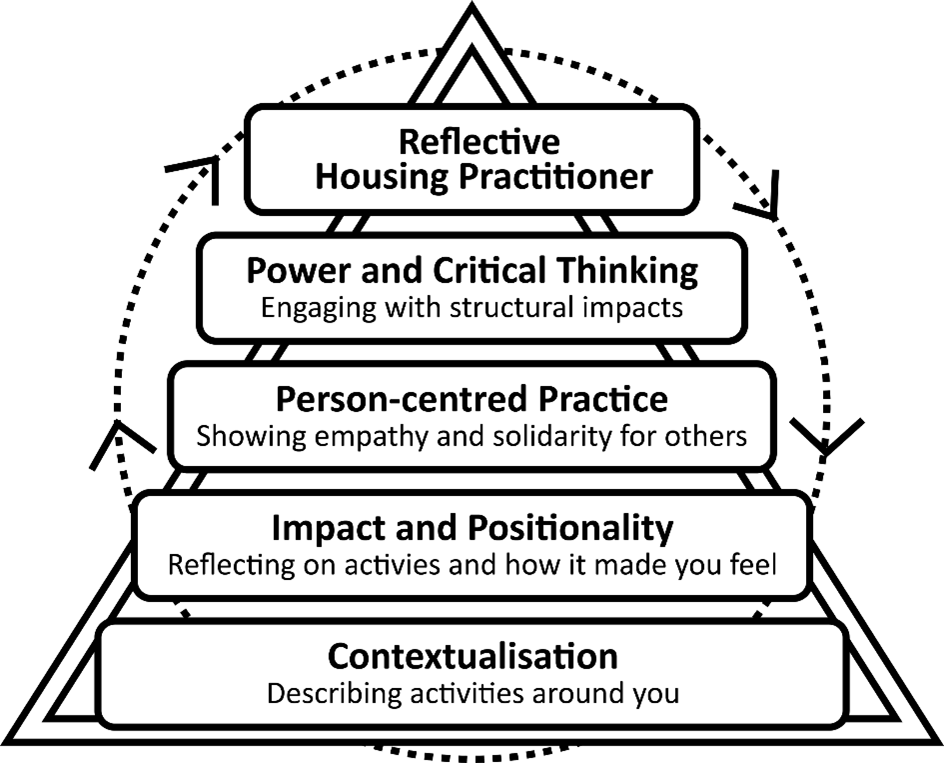Opinion: Housing’s role in tackling intersectional inequalities

The pyramid of reflection in McCall, V., McKee, K., Theakstone, D., Gallagher McCulloch, C., & Taylor, H. (2025)
Prof Vikki McCall and Prof Kim McKee of Stirling University explore how the housing sector can play a crucial role in addressing the intersectional stigma of place-based ageing, highlighting how housing, disability, and ageing intersect to shape experiences of inclusion, exclusion, and discrimination.
Stigma is – unfortunately – a very powerful process that can affect many different groups, which has clear equalities impacts as it contributes to ageism, ableism, place-based stigma and discrimination. The Intersectional Stigma of Place-based Ageing (ISPA) project explores how the housing sector has a key role in tackling stigma in tangible ways.
The ISPA project recently celebrated its year two milestone and is an ambitious 5-year participatory mixed method study exploring how the stigma attached to where people live can intersect with experiences of disability and ageing. The project is a collaboration between the University of Stirling and the University of St Andrews, Newcastle University and University of Bristol, Scottish Federation of Housing Associations (SFHA) and the Housing Learning and Improvement Network (LIN). The Housing LIN host the project pages with more detail, and support the work of the linked Inclusive Living Alliance.
The ISPA project is exploring both the physical form of the dwelling and the intangible space of the ‘home’ – the complex mixture between the impact of the aesthetic, accessibility and the lived experience of spaces to support people to feel safe, secure and at ‘home’. This translates to learning how we support central day-to-day activities that underpin our lives – from being able to access your home, having adaptations that allow you to bathe, eat, sleep, and being able to navigate and interact with the wider neighbourhood in which you live:
By exploring how our homes and communities support inclusion and equality, we gain insight into the activities that the housing sector can implement that tackle peoples’ feelings of difference and stigma.
We aim to gather a variety of evidence to explore this key and important topic, including quantitative data mapping age and disability discrimination that shows the overlap of multiple deprivation, ageing and disability. As disability is concentrated in our more multi-deprived areas (for example 42% of people in the most multiply deprived areas of Scotland are disabled) – are we investing in the right places when we think about housing support?
We are also gathering diaries over two years from over 140 Community-Peer Researchers (CPRs), to understand lived experience and impacts of policy changes, lack of services, and more. This will form a powerful database as a legacy of the project. ISPA integrates co-production with our CPRs involved in the project’s design, delivery, data collection, analysis and dissemination, for example, writing their own blogs and case studies. Housing and social care professionals will also be involved through case studies exploring good practice, which will collect reflective journals from practitioners. This evidence will be the foundation for an Inclusive Living Toolkit, developed with the Inclusive Living Alliance as a key tool for the housing sector by 2027.
What does the literature say
Our recently published evidence review on ‘Understanding the intersectional stigma of ageing, disability, and place: a systematic literature mapping review’ has shown that often in our approach we treat ageing, place and disability in separate ways. By exploring them in combination through an intersectional lens, we see people face not just double markers of stigma (often linked to poverty, place and housing tenure), but also additional barriers due to disability or age-related health issues as they grow older. Yet, experiences of ageing and disability are not universal. Moreover, they are further impacted by other aspects of identity and household economic resources. Whilst our paper showcases the insights of an intersectional lens, there is much more we still need to understand empirically about these complex interactions.
Do you discriminate by design?
Continuing with a focus on the built environment, our report on Discrimination by Design explores the question that if you are not designing inclusively, is that a form of discrimination? We also highlight that the aesthetic – how things look – is incredibly important for equality. For example, participants have shown that ugly, white PVC handrails challenge their sense of dignity, confidence and feelings of home, as well as mark them and their homes as ‘different’ and open to ‘scammers’. We are working with our Inclusive Living Alliance to explore that more inclusively designed homes tackle that sense of difference and exclusion.
Supporting equalities and professionalism
The ISPA Project will also be exploring how we integrate thinking about equalities and inclusion into cultural change in organisations. We will be utilising the model offered in our new paper on ‘The reflective housing practitioner: the role of qualifications for building empathy and person-centred approaches in the housing sector’ . To truly tackle equalities in housing, we need to develop the professionals approaches working in the sector to build empathy, solidarity and engage with the structural inequalities within in.
If you are interested in learning more about our ISPA project, please see our project website, and/or contact the Principal Investigator Prof. Vikki McCall [Vikki.mccall@stir.ac.uk].
This article was originally published on the CaCHE website.









